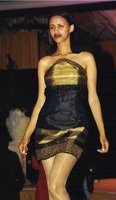
In an article by Indrias Getachew and previously mentioned in Timbuktu Chronicles, it says that "...Several years ago I walked into the outlet store of one of the major leather garment manufacturers located off Debre Zeit Road looking to buy a leather jacket. As I searched through the racks for the right design I noticed something rather peculiar. All the jackets were labeled ‘Made in Korea’. Not one of the jackets had a ‘Made in Ethiopia’ tag.

"Aren’t these jackets made here?" I asked the sales assistant. "Certainly," she replied. "Then why the ‘Made in Korea’ label?" I inquired. She laughed then answered, "who would want to buy something labeled ‘Made in Ethiopia’?"
Things have changed, somewhat, since that visit. I have seen the ‘Made in Ethiopia’ label on various types of garments, both leather and otherwise. That encounter, however, has stuck with me. I recall feeling both sad and annoyed that leather jackets produced in Ethiopia had to have a fake label designating them the product of some alien country in order to sell in the world market. What a travesty. And what a terrible testament regarding the global perception of Ethiopia.
Our ‘Speaking of People’ personality this week is Guenet Fresenbet, an Ethiopian woman on a mission to change this inferior image in the area of textiles and fashion. On the evening of Friday, April 30, 1999, the Lalibela Grand Ballroom at the Sheraton Addis was the venue for the premiere collection of American trained and Ethiopia inspired fashion designer Guenet Fresenbet, or GIGI as she is popularly known. The models walked, strutted, turned, pouted, smiled and posed in the latest fashion sensations to come out of Addis Ababa.
The show featured ‘ecologically friendly’ spring and summer day wear. The playful and attractive, yet reassuringly simple designs were made from 100% traditional hand woven cotton fabrics (shemma), dipped in a variety of natural dying agents including tea, coffee, carrot and avocado. The outfits included thigh length loose fitting dresses in a variety of cuts and designs and hip-hugger bellbottoms with brassiere tops.
Some of the more refined pieces in the collection were made of traditional hand woven ‘tilet’, or jacquard fabric. The delicate material, traditionally used as the colorful trimming on white shemma dresses, was used to create a wide range of outfits including tank-tops and evening dresses. Describing her use of tilet material GIGI explained, "Ethiopian tilet is very common in different colors and patterns. In my collection I use a lot of solid Ethiopian tilet, or jacquard. I use the same colors with different patterns. Some of the styles [presented in the show] have solid colors and might look like some of the new fabrics that are coming out of Japan, but they are all 100% natural Ethiopian fabrics. All the woven fabrics were made by my shemanes (weavers)..."
Photos courtesy of Yohannes.com
1 comment:
I am a young fashion designer, I'm attending Fashion Design university of Florence, I love etiopia textiles and I made a collection inspired from Etiopia arts & crafts...Thanks for this article
ester
Post a Comment